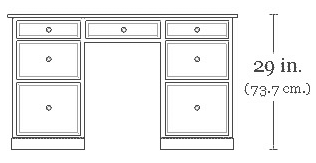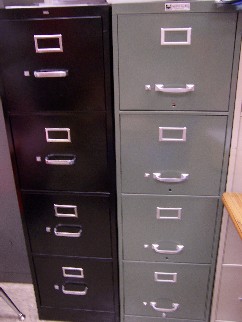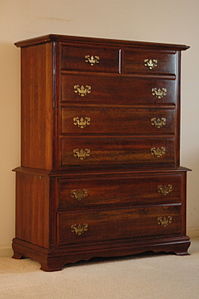
A closet is an enclosed space, with a door, used for storage, particularly that of clothes. Fitted closets are built into the walls of the house so that they take up no apparent space in the room. Closets are often built under stairs, thereby using awkward space that would otherwise go unused.

A pedestal desk or a tanker desk is usually a large, flat, free-standing desk made of a simple rectangular working surface resting on two pedestals or small cabinets of stacked drawers of one or two sizes, with plinths around the bases. Often, there is also a central large drawer above the legs and knees of the user. Sometimes, especially in the 19th century and modern examples, a "modesty panel" is placed in front, between the pedestals, to hide the legs and knees of the user from anyone else sitting or standing in front. This variation is sometimes called a "panel desk". The smaller and older pedestal desks with such a panel are sometimes called kneehole desks, they were intended for small spaces like boudoirs and were usually placed against a wall. The kneehole desks are also known as bureau tables.

A secretary desk or escritoire is made of a base of wide drawers topped by a desk with a hinged desktop surface, which is in turn topped by a bookcase usually closed with a pair of doors, often made of glass. The whole is usually a single, tall and heavy piece of furniture.

A commode is any of many pieces of furniture. The Oxford English Dictionary has multiple meanings of "commode". The first relevant definition reads: "A piece of furniture with drawers and shelves; in the bedroom, a sort of elaborate chest of drawers ; in the drawing room, a large kind of chiffonier." The drawing room is itself a term for a formal reception room, and a chiffonier is, in this sense, a small sideboard dating from the early 19th century.

A filing cabinet is a piece of office furniture for storing paper documents in file folders. In the most simple context, it is an enclosure for drawers in which items are stored. The two most common forms of filing cabinets are vertical files and lateral files. A vertical file cabinet has drawers that extend from the short side of the cabinet. A lateral file cabinet has drawers that extend from the long side of the cabinet. These are also called side filers in Great Britain. There are also shelf files which go on shelves. In the United States, file cabinets are usually built to accommodate 8.5 × 11 paper, and in other countries, filing cabinets are often designed to hold other sizes of paper, such as A4 paper.

A lowboy is an American collectors term for one type of dressing table. It is a small table with one or two rows of drawers, so called in contradistinction to the tallboy or highboy chest of drawers.

A cupboard is a piece of furniture for enclosing dishware or grocery items that are stored in a home. The term gradually evolved from its original meaning: an open-shelved side table for displaying dishware, more specifically plates, cups and saucers.
Campaign furniture is a type of furniture which is made for travel. Historically, much of it was made for military campaigns.

The term chiffonier, also chiffonnier, may refer to one of at least two types of furniture. Its name comes directly from a French piece of furniture, the chiffonier. The French name, which comes from the French for a rag-picker, suggests that it was originally intended as a receptacle for odds and ends which had no place elsewhere.

A chifforobe, also chiffarobe or chifferobe, is a closet-like piece of furniture that combines a long space for hanging clothes with a chest of drawers. Typically the wardrobe section runs down one side of the piece, while the drawers occupy the other side. It may have two enclosing doors or have the drawer fronts exposed and a separate door for the hanging space.

A drawerDROR is a box-shaped container inside a piece of furniture that can be pulled out horizontally to access its contents. Drawers are built into numerous types of furniture, including cabinets, chests of drawers (bureaus), desks, and the like.

A hutch is an American English word for a particular type of furniture with a set of shelves or cabinets placed on top of a lower unit with a counter and either drawers or cabinets. Modern hutches are typically made of timber. The term originates from a hutch table.
A wardrobe or armoire or almirah is a standing closet used for storing clothes. The earliest wardrobe was a chest, and it was not until some degree of luxury was attained in regal palaces and the castles of powerful nobles that separate accommodation was provided for the apparel of the great. The name of wardrobe was then given to a room in which the wall-space was filled with closets and lockers, the drawer being a comparatively modern invention. From these cupboards and lockers the modern wardrobe, with its hanging spaces, sliding shelves and drawers, evolved slowly.

A Welsh dresser or a china hutch, sometimes known as a kitchen dresser or pewter cupboard, is a piece of wooden furniture consisting of drawers and cupboards in the lower part, with shelves and perhaps a sideboard on top. Traditionally, it is a utilitarian piece of furniture used to store and display crockery, silverware and pewter-ware, but is also used to display general ornaments.

A cabinet is a case or cupboard with shelves and/or drawers for storing or displaying items. Some cabinets are stand alone while others are built in to a wall or are attached to it like a medicine cabinet. Cabinets are typically made of wood, coated steel, or synthetic materials. Commercial grade cabinets usually have a melamine-particleboard substrate and are covered in a high pressure decorative laminate, commonly referred to as Wilsonart or Formica.

This high chest of drawers, also known as a highboy or tallboy, is part of the Decorative Arts collection of the Indianapolis Museum of Art in Indianapolis, Indiana. Made between 1760 and 1780 in Philadelphia, Pennsylvania, its design was inspired by British furniture-maker Thomas Chippendale.

The furniture of the Louis XV period (1715–1774) is characterized by curved forms, lightness, comfort and asymmetry; it replaced the more formal, boxlike and massive furniture of the Louis XIV style. It employed marquetry, using inlays of exotic woods of different colors, as well as ivory and mother of pearl.

Louis XVI furniture is characterized by elegance and neoclassicism, a return to ancient Greek and Roman models. Much of it was designed and made for Queen Marie Antoinette for the new apartments she created in the Palace of Versailles, Palace of Fontainebleau, the Tuileries Palace, and other royal residences. The finest craftsmen of the time, including Jean-Henri Riesener, Georges Jacob, Martin Carlin, and Jean-François Leleu, were engaged to design and make her furniture.

A storage bed is a multifunctional furniture consisting of a bed which utilizes storage space which often otherwise is lost, for example by having drawers on its underside or a mattress which can be flipped up to access a storage space beneath. It is an example of a storage furniture or multifunctional furniture, and can accommodate more efficient use of living spaces.




















